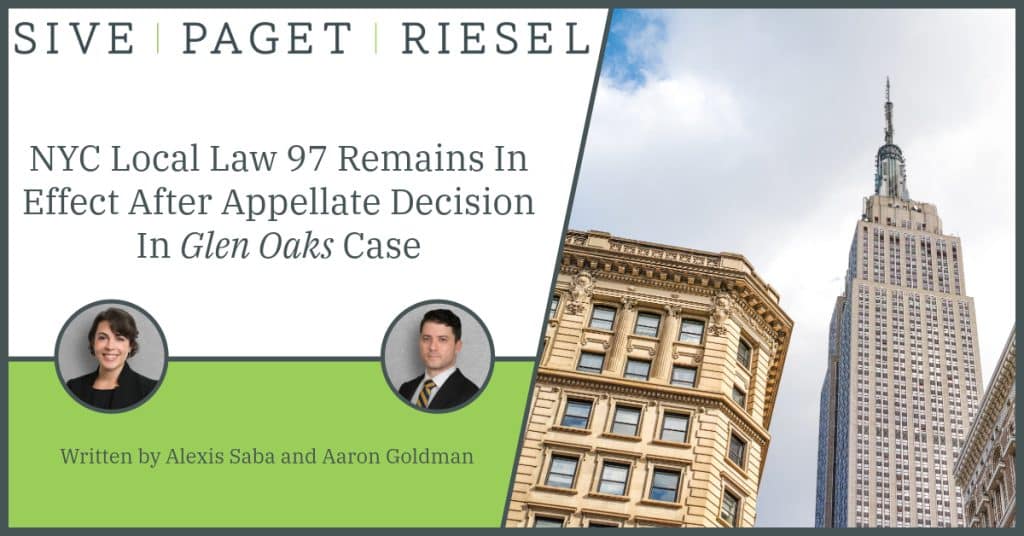Blog

NYC Local Law 97 Remains In Effect After Appellate Decision In Glen Oaks Case
On May 16, 2024, the New York Appellate Division, First Department, reversed in part the trial court decision that dismissed the challenge to New York City’s building emissions law, Local Law 97. The case is Glen Oaks Village Owner, Inc., et al. v. City of New York, et al. (App. Div. No. 2024-00134, Sup. Ct. No. 154327/22), which was brought by a group of building cooperatives, residents, shareholders, and a real estate company. As detailed below, the Appellate Division found that the City did not meet the standard for dismissal of the cause of action claiming that the State Climate Leadership and Community Protection Act (CLCPA) preempts Local Law 97. The parties have 30 days to move to reargue and/or appeal the decision. In the meantime, Local Law 97 remains in effect while the case returns to the trial court for adjudication of the preemption claim.
As previously covered on the SPR Blog, the Plaintiffs alleged that the New York State Legislature intended to occupy the field of greenhouse gas emissions reductions with the CLCPA’s comprehensive regulatory scheme. In moving to dismiss the Complaint, the City countered that the CLCPA does not expressly or impliedly preempt Local Law 97 but rather relies on local greenhouse gas emissions controls for effective and collaborative implementation of the CLCPA’s climate goals. In particular, the City pointed to CLCPA § 11, which provides, “Nothing in this act shall relieve any person, entity, or public agency of compliance with other applicable federal, state, or local laws or regulations, including state air and water quality requirements, and other requirements for protecting public health or the environment.” Supreme Court Justice Machelle Sweeting granted the City’s motion to dismiss, finding that rather than conflicting with Local Law 97, the CLCPA complements local decarbonization and energy efficiency plans and laws.
The Appellate Division reversed Justice Sweeting on the preemption cause of action, relying upon the legal standard for field preemption, as argued by the Plaintiffs, under which a local law regulating the same subject matter as a State-wide statute is deemed inconsistent with the State’s interest, regardless of whether the local law actually conflicts with the State statute. The Appellate Division noted that CLCPA § 10, states: “[n]othing in this act shall limit the existing authority of a state entity to adopt and implement greenhouse gas emissions reduction measures.” The Appellate Division then read the phrase “other applicable . . . local laws” in Section 11 as referring to laws other than the “greenhouse gas emissions reduction measures” referenced in Section 10. Without elaboration, the court concluded there was sufficient potential that the CLCPA intended to preempt local greenhouse gas emissions standards to warrant reversal of Justice Sweeting’s dismissal.
While reinstating the preemption cause of action, the Appellate Division upheld Justice Sweeting’s dismissal of the Plaintiff’s other causes of action, which claimed that (1) Local Law 97 penalties are so excessive and disproportionate to the violation that they violate the Plaintiffs’ due process rights, (2) Local Law 97 leaves too much discretion to regulatory agencies and therefore is unconstitutionally vague, and (3) Local Law 97’s regulation of existing buildings is unconstitutionally retroactive. On appeal, the Plaintiffs abandoned their cause of action dismissed by the trial court that Local Law 97 penalties effectively operate as a tax on carbon emissions rather than a fine.
In addressing the Plaintiff’s argument that Local Law 97 is disproportionately punitive on its face, the court held that to challenge the facial validity of a law, rather than its application to a particular party, the law must be invalid under any set of circumstances and that the Plaintiffs did not satisfy this standard in regard to penalty amounts. The court also held that a facial challenge on vagueness grounds is only available where the vagueness is so great that the enforcement agency can exercise unfettered discretion in every case. The court found that Local Law 97’s penalty mitigation factors do not convey such unfettered discretion to the NYC Department of Buildings. Finally, the court held that a law is not retroactive simply because it regulates future conduct that relates to and is founded upon antecedent events, as is the case with Local Law 97.
While the parties continue to litigate the preemption cause of action, Local Law 97 is still in effect. Compliance reports for most covered buildings, including demonstration of any penalty mitigation factors, are due on May 1, 2025 based on compliance during 2024.